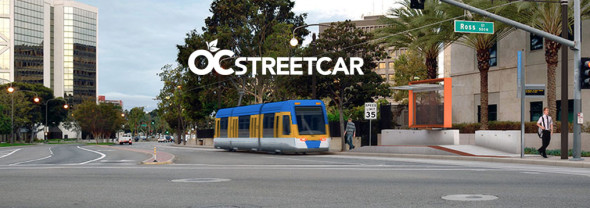
The OC Streetcar Project, the expected first of its kind in Orange County, was awarded $28 million last week as part of California's Transit and Intercity Rail Capital Program, which is funded by the state's cap-and-trade program.
The California State Transportation Agency (CalSTA) administers the TIRCP, which seeks to reduce statewide greenhouse gas emissions through rail and transit capital investments. The TIRCP awards totaled $390 million statewide--see Streetsblog coverage here.
The OCTA board of directors on Monday approved a motion to accept the funds, and to increase funding for the streetcar from other existing sources. It voted to redirect $9.17 million in FTA funding from the Anaheim Regional Connector Project--thus increasing total FTA funds for the streetcar from $4.09 million to $13.26 million--and added $5.32 million Measure M2 Project S funds, thus raising the amount of Measure M2 funds for the streetcar from $51.83 million to $57.15 million.
“California’s cap-and-trade Program is critical in helping us invest in transit that will provide viable transportation options as Orange County continues to evolve,” said OCTA Chair Lori Donchak. “I appreciate that the state recognizes the importance of the OC Streetcar and this funding moves the project one step closer to fruition.”
The TIRCP funding will also be used to help roll out systemwide mobile ticketing, wherein passengers can purchase and use bus passes through their smart phone. Though the rollout is planned for next summer, the mobile ticketing system is currently operating in a beta phase with OCTA's fixed-route fleet, which includes bus routes 701, 721, and 794.
The OC Streetcar is planned along a 4.1-mile route from the Santa Ana Regional Transportation Center, through Downtown Santa Ana and the Civic Center, along the Pacific Electric right of way, to connect to a new multimodal transit hub at Harbor Boulevard and Westminster Avenue in Garden Grove. Up to six streetcars will run along the route, stopping every ten minutes during peak hours at ten stations in each direction.
“The OC Streetcar project provides a clean mobility option through some of the most populated areas of the county,” said CalSTA Secretary Brian Kelly. “The project will provide meaningful access to jobs, job training, healthcare, and education, using zero-emission streetcars. This is a win for the economy in both Santa Ana and Garden Grove and their quality of life.”
OCTA is the lead agency developing the estimated $297.9 million OC Streetcar project, with additional funding coming from various federal and local sources, including Measure M, the county’s half-cent sales tax for transportation improvements.
It’s expected that the OC Streetcar and mobile ticketing projects will lead to the reduction of 539,000 tons of greenhouse gas emissions over the next fifty years.
OCTA has also been working on the streetcar with the Federal Transit Administration through the federal New Starts program. In February, President Barack Obama included $125 million in the federal budget for the streetcar. Both the House and the Senate have also added funding for the OC Streetcar as part of their appropriation process, signaling strong federal support for the project.
On the current schedule, construction for the OC Streetcar would begin in 2018, with service beginning in 2020. The streetcar is expected to carry more than 7,500 riders a day.
CalSTA’s TIRCP Program has also helped fund other OCTA services, including a $2.3 million grant to launch Bravo! 560, a limited-stop bus service that provides a quicker commute between Santa Ana and Long Beach.
In addition, OCTA has received nearly $5 million from the GGRF to help reduce bus fares.





